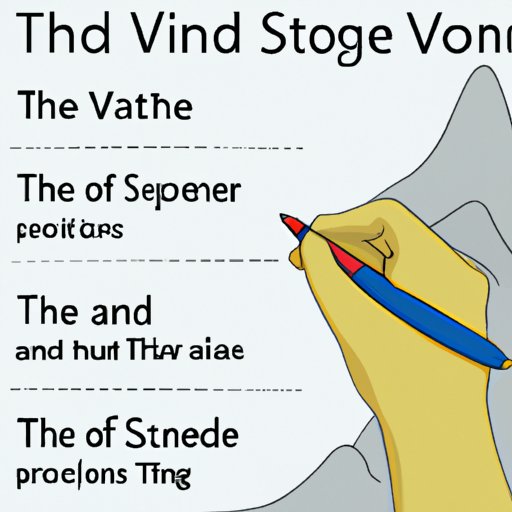Introduction
Writing in the third person can be a challenging task, especially if you’re new to the concept. But with the right guidance and practice, you can master the art of 3rd person writing. This article will provide an overview of what 3rd person writing is, explain the differences between 1st, 2nd, and 3rd person writing, and offer tips for crafting fiction in the third person perspective.

Explaining 3rd Person Writing: A Comprehensive Guide
What is 3rd Person Writing?
Third person writing is a style of writing where the writer uses pronouns like “he,” “she,” “it,” or “they” to refer to the characters in the story. In 3rd person writing, the narrator is not part of the story and is instead an outside observer of the events that unfold. This type of writing allows the writer to create more distance between the reader and the characters, allowing the writer to explore the story from multiple perspectives.
Types of 3rd Person Writing
There are two types of 3rd person writing: limited and omniscient. In limited 3rd person writing, the narrator is limited to the thoughts and feelings of one character. This type of writing allows the reader to experience the story through the eyes of the protagonist but still maintain some level of detachment. Omniscient 3rd person writing, on the other hand, gives the narrator access to the thoughts and feelings of all of the characters in the story. This type of writing allows the writer to explore the story from multiple points of view.
Advantages of Using 3rd Person Writing
Writing in the third person has several advantages. It allows the writer to create a more objective tone and keep the focus on the characters and their actions. It also helps the reader develop a better understanding of the characters by providing insight into their thoughts and feelings. Finally, 3rd person writing makes it easier to establish a clear narrative arc since the narrator is not directly involved in the story.

Crafting Fiction in the Third Person Perspective
Choosing the Right Narrative Voice
When writing in the third person, it’s important to decide on the right narrative voice. Will the narrator be close to the characters or remain distant? Will the narrator use a formal or informal tone? These choices can have a big impact on how the story is told and can help create a unique perspective for the reader.
Creating a Unique Character Perspective
When writing in the third person, it’s important to create a unique character perspective. Each character should have a distinct personality and set of motivations that influence their actions. By exploring each character’s inner world, the writer can create a deeper connection between the reader and the characters.
Writing with Clarity and Focus
When writing in the third person, it’s important to maintain clarity and focus. The narrator should be able to move the story forward without getting bogged down in unnecessary details or digressions. By keeping the narrative focused and concise, the writer can ensure that the reader remains engaged with the story.
Understanding the Difference Between 1st, 2nd, and 3rd Person Writing
The Basics of 1st Person Writing
In 1st person writing, the narrator is a character in the story and uses pronouns like “I” and “me” to refer to themselves. This type of writing allows the reader to experience the story through the eyes of the protagonist and gain a deeper understanding of their thoughts and feelings. The downside of 1st person writing is that it can be limiting since the narrator is only able to tell the story from their own perspective.
The Basics of 2nd Person Writing
In 2nd person writing, the narrator uses pronouns like “you” and “your” to address the reader directly. This type of writing allows the writer to create a direct connection between the reader and the story. The downside of 2nd person writing is that it can be difficult to maintain consistency since the narrator is constantly shifting between addressing the reader and telling the story.
The Basics of 3rd Person Writing
As mentioned earlier, 3rd person writing is a style of writing where the narrator is an outside observer of the events that unfold. The narrator uses pronouns like “he,” “she,” “it,” or “they” to refer to the characters in the story. This type of writing allows the writer to create more distance between the reader and the characters, allowing the writer to explore the story from multiple perspectives.

How to Use 3rd Person Point of View in Your Writing
Deciding on Your Narrator
When writing in the third person, it’s important to decide on the right narrator. Will the narrator be close to the characters or remain distant? Will the narrator use a formal or informal tone? These choices can have a big impact on how the story is told and can help create a unique perspective for the reader.
Establishing the Tone and Style
When writing in the third person, it’s important to establish the right tone and style. The narrator should be able to convey the emotions of the characters without being too melodramatic or overwrought. By finding the right balance between emotion and objectivity, the writer can ensure that the reader stays engaged with the story.
Choosing the Right Level of Detailing
When writing in the third person, it’s important to choose the right level of detailing. Too much detail can slow down the pace of the story, while too little detail can make the story feel flat and dull. The key is to find the perfect balance between providing enough detail to engage the reader without overwhelming them.
Tips for Writing in the Third Person
Keep the Narrator’s Voice Consistent
When writing in the third person, it’s important to keep the narrator’s voice consistent. The narrator should use the same tone and style throughout the story to ensure that the reader remains engaged. If the narrator’s voice changes too often, the reader may become confused or lose interest in the story.
Develop Multiple Perspectives
When writing in the third person, it’s important to develop multiple perspectives. The writer should explore the thoughts and feelings of the characters to give the reader a better understanding of their motivations and decisions. By exploring multiple perspectives, the writer can create a richer and more engaging story.
Avoid Unnecessary Description
When writing in the third person, it’s important to avoid unnecessary description. Too much description can slow down the pace of the story and distract the reader from the main plot. The key is to provide just enough description to engage the reader without overwhelming them.
Benefits of Writing in the Third Person Perspective
Increased Accessibility
Writing in the third person allows the writer to create a more accessible story. By using pronouns like “he,” “she,” “it,” and “they,” the writer can create a story that appeals to a wider audience. This type of writing also allows the writer to explore the story from multiple perspectives, which can help the reader gain a better understanding of the characters and their motivations.
More Objective Writing
Writing in the third person allows the writer to create a more objective tone. Since the narrator is not a character in the story, they can observe the events that unfold without getting caught up in the drama. This type of writing also allows the writer to explore the story from different angles, which can help the reader gain a deeper understanding of the characters and their decisions.
Enhanced Reader Engagement
Writing in the third person allows the writer to create a more engaging story. By exploring the thoughts and feelings of the characters, the writer can create a deeper connection between the reader and the story. This type of writing also allows the writer to craft a compelling narrative arc that keeps the reader engaged until the very end.
Conclusion
Writing in the third person can be a challenging task, but with the right guidance and practice, anyone can master the art of 3rd person writing. This article has provided an overview of what 3rd person writing is, explained the differences between 1st, 2nd, and 3rd person writing, and offered tips for crafting fiction in the third person perspective. Writing in the third person has several advantages, including increased accessibility, more objective writing, and enhanced reader engagement. With the right approach, anyone can learn to write in the third person and create engaging stories that readers will love.
(Note: Is this article not meeting your expectations? Do you have knowledge or insights to share? Unlock new opportunities and expand your reach by joining our authors team. Click Registration to join us and share your expertise with our readers.)
